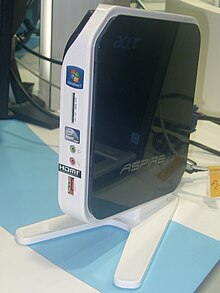
Dell XPS is a line of consumer-oriented laptop and desktop computer series manufactured by Dell since 1993.

An ultra-mobile PC, or ultra-mobile personal computer (UMPC), is a miniature version of a pen computer, a class of laptop whose specifications were launched by Microsoft and Intel in Spring 2006. Sony had already made a first attempt in this direction in 2004 with its Vaio U series, which was only sold in Asia. UMPCs are generally smaller than subnotebooks, have a TFT display measuring (diagonally) about 12.7 to 17.8 centimetres, are operated like tablet PCs using a touchscreen or a stylus, and can also have a physical keyboard. There is no clear boundary between subnotebooks and ultra-mobile PCs, but UMPCs commonly have major features not found in the common clamshell laptop design, such as small keys on either side of the screen, or a slide-out keyboard.

Asus Eee is a family of products by AsusTek Computer Inc. The product family began with the release of the Eee PC subnotebook in 2007; since then, the product family has diversified into a number of PC form factors. According to the company, the name Eee derives from "the three Es," an abbreviation of its advertising slogan for the device: "Easy to learn, Easy to work, Easy to play".
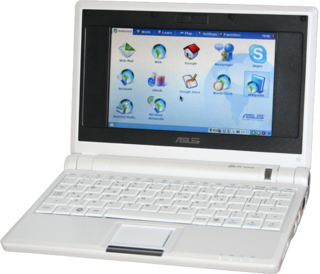
The ASUS Eee PC is a netbook computer line from Asus, and a part of the ASUS Eee product family. At the time of its introduction in late 2007, it was noted for its combination of a lightweight, Linux-based operating system, solid-state drive (SSD), and relatively low cost. Newer models added the options of Microsoft Windows operating system and rotating media hard disk drives (HDD), and initially retailed for up to 500 euros.

Dell Vostro is a line of business-oriented laptop and desktop computers manufactured by Dell aimed at small to medium range businesses. From 2013–2015, the line was temporarily discontinued on some Dell websites but continued to be offered in other markets, such as Malaysia and India.

TravelMate is a line of business-oriented laptop computers manufactured by Acer. Of the various notebook series Acer has offered, the TravelMate is designated as a lightweight business and professional computer built to withstand day-to-day activities. Travelmate laptops are well received by reviewers, often, however, they are faulted for a lack of visual appeal. The TravelMate name was previously used by Texas Instruments, which sold its mobile computing division to Acer in 1997. The TravelMate mainly competes against business computers such as Dell's Latitude, HP's EliteBook and ProBook, Lenovo's ThinkPad and Toshiba's Portégé.
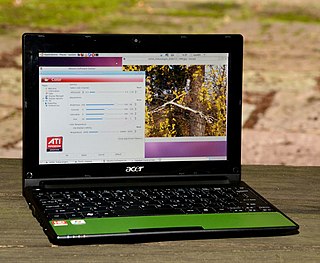
Acer Aspire One is a line of netbooks first released in July 2008 by Acer Inc.

A mini PC is a small-sized, inexpensive, low-power, legacy-free desktop computer designed for basic tasks such as web browsing, accessing web-based applications, document processing, and audio/video playback.

The Asus Eee Top is a touch screen all-in-one desktop computer designed by Asus and released in November 2008. Its motherboard employs Splashtop technology called "ExpressGate" by Asus.
Nvidia Ion was a product line of Nvidia Corporation intended for motherboards of low-cost portable computers. It used graphics processing units and chipsets intended for small products.

HP TouchSmart is a series of tablet PC laptops and touchscreen all-in-one desktop computers designed by HP. It features various Intel or AMD processors and runs Windows Vista or Windows 7 as standard.
The Dell Inspiron Mini Series is a line of subnotebook/netbook computers designed by Dell. The series was introduced in September 2008 amidst the growing popularity of low-cost netbook computers introduced by competitors.

HP Mini is a former line of small computers categorized as netbooks manufactured by Hewlett-Packard. They either contained a custom version of Ubuntu Linux, Microsoft Windows XP Home Edition or Windows 7 Starter operating system. Like most netbooks, they were not built with CD/DVD drives. They were announced from mid-2007, and marketed from 2008 through 2012.

Acer Aspire is a series of personal computers by Acer Inc. aimed at casual household use or for light business use. The Aspire series covers both desktop computers and laptops.

The Acer Iconia is a range of tablet computers from Acer Inc. of Taiwan.
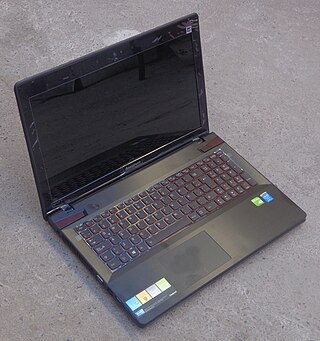
The IdeaPad Y series was a consumer range of laptops produced by Lenovo, first announced in 2008. They were marketed as premium high performance laptops for multimedia and gaming, as part of the IdeaPad line.
The Lenovo IdeaCentre Q series are a line of nettop computers meant primarily for home and personal use. The Q Series nettops are described by the manufacturer as being multimedia-oriented nettops. Comparing the size to a typical paperback book, Lenovo describes the Q Series nettops as the smallest desktops in production. The general features of the Q Series desktops are the small size, low energy requirements, ability to play HD video, and low noise levels.
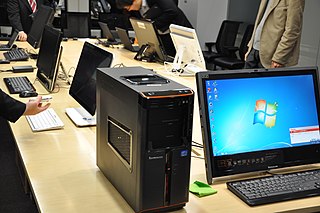
The Lenovo IdeaCentre is a line of consumer-oriented desktop computers designed, developed and marketed by Lenovo. The first IdeaCentre desktop, the IdeaCentre K210, was announced by Lenovo on June 30, 2008 as a consumer-focussed alternative to the business-oriented ThinkCentre and ThinkStation brandnames acquired from IBM. While the IdeaCentre line consists entirely of desktops, they share a common design language with the IdeaPad line of laptops and hybrids. One such feature is Veriface facial recognition technology.
Lenovo’s line of Essential desktops is a collection of budget-conscious machines designed for consumers, and advertised as being "affordable, space saving, and energy efficient". The Essential desktop line is different from both Lenovo’s ThinkCentre line and Lenovo’s IdeaCentre line. Lenovo defines its ThinkCentre desktops as business-oriented computers, while the IdeaCentre desktops are meant primarily for entertainment. The Essential range of desktops can be categorized as being between the two – meant more for ordinary everyday use.

On June 26, 2007, Dell released the new Inspiron desktop series, under the Dell Inspiron branding, as a replacement to the Dell Dimension desktop computers.
